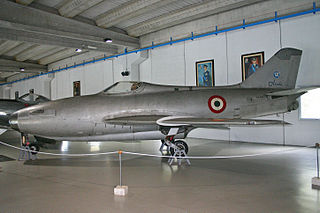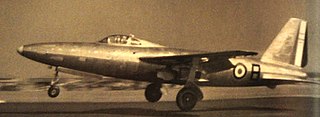
The McDonnell XF-88 Voodoo was a long-range, twinjet fighter aircraft with swept wings designed for the United States Air Force. Although it never entered production, its design was adapted for the subsequent supersonic F-101 Voodoo.

The Bell XP-83 was a United States prototype jet escort fighter designed by Bell Aircraft during World War II. It first flew in 1945. As with most early first generation jet fighters, the design was hampered by a relative lack of power. With the rapid advancements in jet technology post-WWII, the XP-83 was soon eclipsed by more advanced designs and it never entered production.

The Douglas D-558-2 Skyrocket is a rocket and jet-powered research supersonic aircraft built by the Douglas Aircraft Company for the United States Navy. On 20 November 1953, shortly before the 50th anniversary of powered flight, Scott Crossfield piloted the Skyrocket to Mach 2, or more than 1,290 mph (2076 km/h), the first time an aircraft had exceeded twice the speed of sound.

The North American X-10 was an unmanned technology demonstrator developed by North American Aviation. It was a subscale reusable design that included many of the design features of the SM-64 Navaho missile. The X-10 was similar to the development of the Bell X-9 Shrike project, which was based on features of the GAM-63 RASCAL.

The Aerfer Ariete was a prototype fighter aircraft built in Italy in 1958. It was a refined derivative of the Aerfer Sagittario 2, and was an attempt to bring that aircraft up to a standard where it could be mass-produced as a viable combat aircraft.

The Convair XF-92 was an American, delta wing, first-generation jet prototype. Originally conceived as a point-defence interceptor, the design was later used purely for experimental purposes and only one was built. However, it led Convair to use the delta-wing on a number of designs, including the F-102 Delta Dagger, F-106 Delta Dart, B-58 Hustler, the US Navy's F2Y Sea Dart as well as the VTOL FY Pogo.

The Yakovlev Yak-19 was a prototype Soviet fighter built in late 1940s. It was the first Soviet aircraft to be equipped with an afterburning turbojet, the Klimov RD-10F that was derived from the German Jumo 004 engine. Only two examples were built as it was rejected for service by the Soviet Air Force.
The Martin XB-68 was a supersonic medium tactical bomber with a crew of two that was proposed in 1954 to the United States Air Force. The project, however, was canceled before any aircraft were built.

The Nord 1500 Griffon was an experimental ramjet-powered interceptor aircraft designed and built by French state-owned aircraft manufacturer Nord Aviation. The Griffon was developed to become a Mach 2 follow on to the supersonic Nord Gerfaut research aircraft. Development of the aircraft began in earnest after the receipt of a letter of intent in 1953 for a pair of unarmed research aircraft. The design featured an innovative dual propulsion turbojet-ramjet configuration; the former being used to takeoff and attain sufficient speed to start the latter.

The Bereznyak-Isayev BI-1 was a Soviet short-range rocket powered interceptor developed during the Second World War.

The SNECMA C.450 Coléoptère was a vertical take-off and landing (VTOL) aircraft that was designed by the French company SNECMA and manufactured by Nord Aviation. While work on the aircraft proceeded to the test flying phase, the project never progressed beyond experimental purposes.
The Sukhoi Su-5 or I-107 was a Soviet mixed-power prototype fighter aircraft built toward the end of World War II.

The Sukhoi Su-15 was a prototype Soviet all-weather interceptor which never reached production. The designation was later reused for an entirely different 1960s interceptor, see Sukhoi Su-15.

The Arsenal VG 70 was a single-seat monoplane research aircraft flown in France shortly after World War II to assist in the development of high-speed jet fighters. Lacking an indigenous turbojet engine, the aircraft was fitted with a German Junkers Jumo 004. Unlike most jet-powered aircraft of the period, the swept wing was wooden as was the tail structure. The under-powered VG 70 made its maiden flight in 1948, but only flew five times before the program was terminated the following year.

The Arsenal VG 90 was a French carrier-based jet-engined interceptor developed in the late 1940s. It was intended to compete for an Aéronavale contract and first flew in 1949. It set a speed record for a French aircraft the following year, but both of the completed prototypes were destroyed in fatal crashes and the program was cancelled in 1952 before the third prototype was finished. The Aéronavale contract was eventually awarded to a license-built British aircraft. The remains of the last VG 90 were scrapped in 1978.

The EFW N-20 Aiguillon was Switzerland's first indigenous jet fighter project. The Swiss Federal Aircraft Factory developed a design for a four-engined swept winged fighter following the end of the Second World War. An unpowered sub-scale N-20.01 glider and a turbojet powered test aircraft, also sub-scale and known as the N-20.02 Arbalète ("Crossbow"), were test flown. A fighter prototype N-20.10 Aiguillon was built but never flown, and a twin-engines N.20.20 Harpon was also proposed but not followed up.

The Nord Gerfaut (Gyrfalcon) was a French delta-wing experimental research aircraft. It was the first European aircraft to exceed Mach 1 in level flight without the use of an afterburner. A pair of aircraft were built for the primary purpose of investigating the transonic regime. The Gerfaut I conducted its maiden flight in 1954; it was followed by the improved Gerfaut II two years later. Both aircraft were flown for several years for experimental purposes, being significantly upgraded over time. During the course of these test flights, the second prototype establishment multiple time-to-altitude world records. In the late 1950s, the type was used to flight-test various aerial missiles. Both aircraft performed their final flights in 1959; they were subsequently used as targets at the Military Test Range at Cazaux.

The Leduc 0.21 was a research aircraft built in France in 1953 to refine the practicalities of ramjet propulsion. Initially proposed as the 0.20, it was essentially similar to its predecessor, the Leduc 0.10, but scaled up by around 30%, with tip tanks added to the wings. It was not capable of take-off under its own power, and had to be carried aloft and released.

The Leduc 022 was the prototype of a mixed-power French interceptor built in the mid-1950s. Designer René Leduc had been developing ramjet-powered aircraft since before World War II and had flown a series of experimental aircraft, the Leduc 0.10 and Leduc 0.21, throughout the Fifties before he was awarded a contract for two examples of a short-range supersonic interceptor armed with two air-to-air missiles (AAMs).

The Sud-Ouest SO.6020 Espadon (Swordfish) was a French post-war prototype interceptor designed and built by SNCASO during the late 1940s. The French Air Force judged the design a failure despite some records being set and cancelled plans to put it into service in 1951. Only four aircraft were built and they were later modified to serve as testbeds for the mixed rocket and turbojet-powered SNCASO SO.9000 Trident program. Only one badly damaged aircraft survives.


















